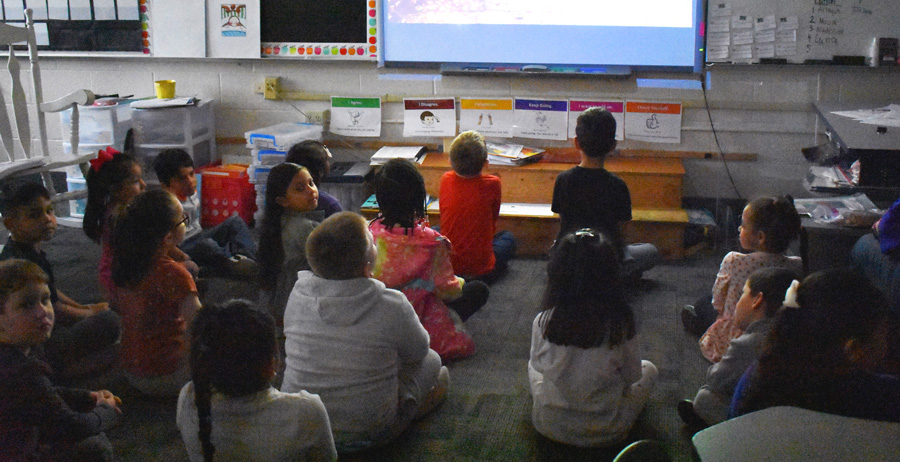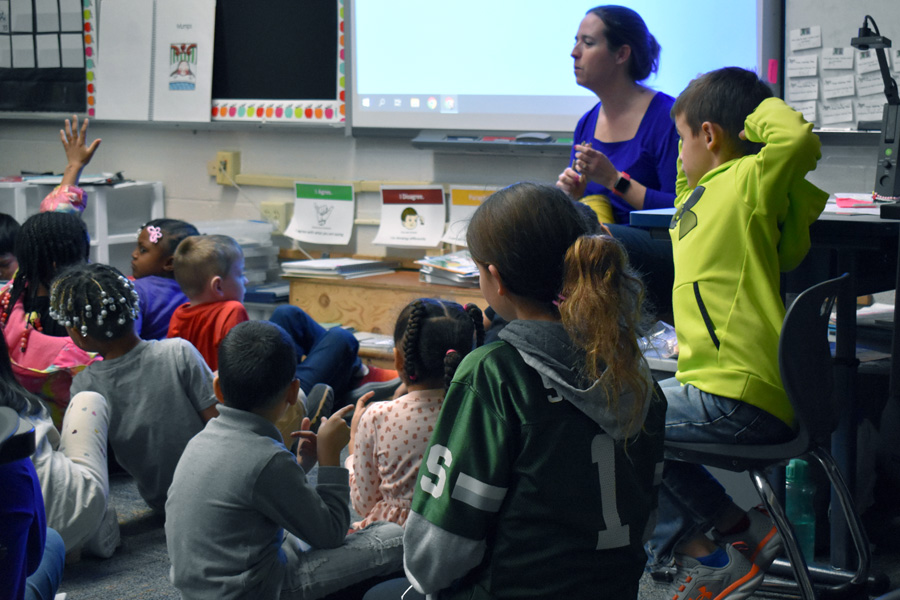Godwin Heights — It all starts with a ding.
“That (sound) is so important because there is no other place in school where a chime is used,” said Alicia Hagan, West Godwin’s social worker.
With that sound, a “do not disturb” sign is posted outside the room and the lights are turned down. The kindergartners in teacher Christina VanderVelde’s class sit quietly on the rug facing the screen, where a two-minute video is about to start.
The video takes the students and their teacher through a series of mindfulness exercises, from breathing to movement, to help reduce stress and anxiety while at the same time boost mental and emotional well-being.
“I thought our teachers needed some more tools in their toolbox for social emotional learning and mindfulness felt like a really concrete, easy thing to do,” Hagan said. “I was like, ‘It is just so simple, why aren’t we doing it?’”
Given the challenges students face, many are dealing with chronic stress, a consistent sense of feeling pressured and overwhelmed, she said. Being on high alert due to that stress can lead to both mental and physical health issues.
“We can teach kids all day long about anxiety, worries and friendships, but at the end of the day, if our kids don’t know how to calm down, if they don’t have something in their toolbox to help them get regulated again, we’re going to continue to be stuck,” Hagan said.
Help a Body Calm Down
Godwin Heights already has a district-wide social emotional learning curriculum, but Hagan wanted to add something that would focus on mindfulness.
Going through mindfulness exercises activates both hemispheres of the brain, she said, which stimulates working memory connected to reading comprehension and emotional regulation. The process also helps to reduce stress and anxiety along with helping a body to calm down.
In researching classroom mindfulness resources, Hagan discovered Calm Classroom, which provides two- to four-minute videos with scripted breathing, stretching, focusing and relaxation techniques that can be led by teachers and/or students. She liked that the program was designed for all learning styles and physical abilities, and that it could be used by students from pre-kindergarten up through grade 12.
With help from Kent School Services Network, Hagan was able to receive funding to train and pay for a year’s membership. Training was about $70 per teacher, including supplies.
In the fall, Hagan offered a training session with eight West Godwin kindergarten and first-grade teachers. Since then, the teachers have decided how they wanted to implement the program in their own classrooms. Some do their mindfulness exercises at the beginning of class; others, like VanderVelde, schedule time during the day.
Since Calm Classroom is a new program, Hagan does not yet have data on how it’s working. She did, however, conduct a survey asking students if they knew what mindfulness was and if they felt they could teach the exercises to another person.
“That’s really like my goal,” Hagan said. “I want these kids to be able to teach it to somebody else.”

‘It Makes Me Feel Like a Princess’
Kindergartner Nova Brown said she was certain she could teach some exercises to her brother.
“It makes my body feel great and I love every one of them and it makes me feel like a princess,” Nova said about why she enjoys participating in the mindfulness program. Her favorite part is when she gets to lie down, she said.
At the end of each lesson, teachers ask a reflection question that is grade-appropriate. In VanderVelde’s class, the question of the day was, “How does your body feel?” She pulled names out of a can one by one to give each kindergartner the chance to respond.
“I feel good,” answered one student. When her time came, Nova quickly responded, “I feel really, really, really good.”
On that note, VanderVelde rang the chime while a student switched on the classroom lights and removed the sign on the door. Time to move on to the next lesson.












